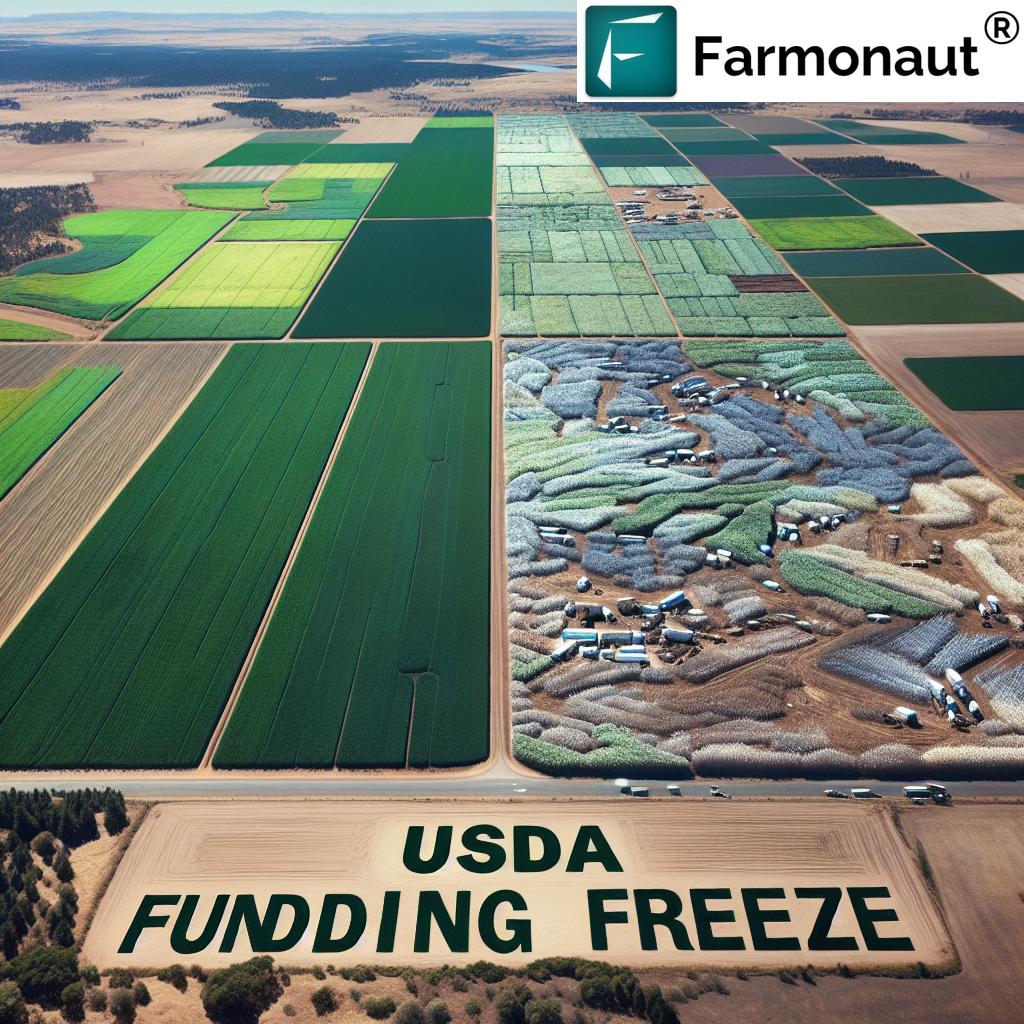Table of Contents
- Introduction: The Cornerstone of Agriculture & Land Loans in Sulphur Springs, Conrad MT
- Montana Agriculture in Context: Sulphur Springs & Conrad
- Why Agriculture & Land Loans Matter for 2025
- Unique Challenges Shaping Loan Demand
- Key Loan Options for Farmers in Sulphur Springs & Conrad MT
- Loan Comparison Table
- Navigating the Loan Application & Approval Process in 2025
- Local Support & Resources: Community Role in Financing Success
- Modern Technology In Agriculture & Financing: The Farmonaut Perspective
- Best Strategies for Maximizing Loan Benefits & Ensuring Sustainability
- 2025 Outlook: Evolving Roles and Opportunities for Agricultural Loans
- Frequently Asked Questions
- Conclusion
“Agricultural land loans in Conrad, MT averaged $3,100 per acre financed in 2023—up 9% from the previous year.”
Agriculture & Land Loans Sulphur Springs, Conrad MT Guide: The 2025 Perspective
Agriculture & land loans in Sulphur Springs, Conrad MT are more than a financial vehicle; they’re the foundation enabling rural Montana’s modern farming landscape to thrive amid evolving market realities and climatic variables. As we enter 2025, strong access to customized financing underpins the success, resilience, and ongoing transformation of farms and agricultural operations across this deeply rooted region.
Farmers in Sulphur Springs and Conrad are pivotal contributors to Montana’s proud agricultural heritage. These communities, serving family farms, growing agribusinesses, and next-gen stewards of the land, rely on robust financial tools to meet rising land prices, increased demand for sustainability, the drive toward technology-enabled efficiency, and the escalating need to weather market volatility.
In this comprehensive guide, we’ll explore agriculture & land loans in Sulphur Springs, Conrad MT, covering financing options, strategies for 2025, essential support systems, and the innovative technologies shaping the region’s future. We aim to empower you with knowledge and actionable insights to navigate competitive lending landscapes and unlock opportunities for successful, sustainable Montana farming.
Montana Agriculture in Context: Sulphur Springs & Conrad as Pillars of Production
The state of Montana is rich in agricultural diversity, especially in north-central regions like Sulphur Springs and Conrad. This area is characterized by:
- Wheat, barley, and pulse crop production—key drivers of local and export markets
- Cattle ranching and diverse farm operations, reflecting a mosaic of family and corporate entities
- Soil health and water management practices, crucial for long-term viability
- Innovative farming activities, including adoption of new technology, crop varieties, and conservation incentives
Sulphur Springs and Conrad are not only geographically important, serving as critical agricultural production hubs, but culturally as well, being home to legacy families and emerging young operators. Their deeply rooted connection to the land is matched by a progressive outlook toward investment, efficiency, and environmental stewardship.
As the industry in Montana progressively adopts precision farming, sustainable practices, and improved technology, financing options tailored to these evolving needs will help local farms capitalize on both current and future opportunities.
The Importance of Agriculture & Land Loans — 2025 and Beyond
Why are agriculture & land loans Sulphur Springs, Conrad MT agriculture loans so vital? In 2025, these financial products are the cornerstone of resilient, expanding, and sustainable farm operations. Here’s why:
- Capital Access for Land Purchase: Skyrocketing land prices and shifting land use dynamics (including conservation programs) increase competition for quality acreage. Loans enable farmers to purchase new parcels, expand existing operations, and maintain productive continuity.
- Upgrading Equipment & Technology: Modern agriculture requires substantial, ongoing investments in equipment, irrigation infrastructure, and digital systems to keep up with industry innovation and boost efficiency.
- Cash Flow Management: Agricultural cycles are seasonal. Flexible loans help farmers smooth cash flow, especially during planting, growing, and harvesting cycles, or when weather or market shifts disrupt expected income.
- Climate Resilience: Given unpredictable weather and climate variability, loans that support investments in drought-resilient systems, advanced irrigation, and soil health improvements help safeguard long-term productivity.
- Sustainability & Compliance: Many loans now integrate incentives or tie-in with government programs to promote sustainable management, conservation, and climate-smart practices.
These loans don’t just offer money—they enable technological adoption, allow for expanding operations, support new generations of growers, and secure the agricultural landscape against both current and future challenges.
“Over 65% of new farm loans in Sulphur Springs in 2024 supported sustainable and innovative farming business ventures.”
Specific Challenges in Sulphur Springs and Conrad: Why Tailored Loans Remain Essential
No two rural communities face the same mix of obstacles and opportunities. Sulphur Springs and Conrad MT have their own unique challenges driving the need for flexible, specialized agriculture & land loans:
1. Rising Land Prices & Availability
Land values in the region have seen steady increases, driven by escalating demand from both production expansion and conservation initiatives (e.g., conservation easements, habitat protection). For those wishing to expand operations or enter the market, significant financing is crucial.
2. Climate Challenges: Resilience Investments Are Critical
Climate variability—with heightened risk of drought, late frosts, and unpredictable precipitation—demands proactive investment in climate-resilient systems. Loans that finance improved irrigation, drought-resistant seeds, and advanced soil management are now pivotal for mitigating these risks.
3. Infrastructure Modernization
Outdated infrastructure places a hard limit on farm productivity. Flexible loan products that allow for modernization of barns, grain storage, fencing, and livestock handling facilities are vital to meeting animal welfare and product quality standards.
4. Market Fluctuations & Operating Liquidity
Volatile markets for wheat, barley, pulses, and cattle mean unpredictable prices. Operating lines of credit provide much-needed working capital when input costs spike, markets drop, or inventory needs to be held until prices recover.
5. Inflation and Input Costs
In 2025, inflationary pressures continue to affect fertilizer, seed, fuel, and equipment prices, forcing farmers to seek larger, more adaptable loans to cover higher input costs while maintaining production targets.
Key Loan Options for Farmers in Sulphur Springs & Conrad MT (2025)
Whether you are seeking to secure land, upgrade irrigation, invest in equipment, or simply stabilize operations, a range of agriculture & land loans sulphur springs, conrad mt agriculture loans are available in 2025. Here are the most relevant types:
USDA Farm Service Agency (FSA) Loans
- FSA Direct Loans: For land acquisition, construction/improvement of farm buildings, and equipment. Especially supportive of beginning farmers and those recovering from adversity. Preferential terms and lower down payments compared to private lending.
- FSA Guaranteed Loans: Partnered with local banks or lending institutions, with government backing to reduce lender risk—expanding access to larger or riskier borrowers.
- Operating Loans (Direct & Guaranteed): Seasonal working capital for input costs, labor, and operational expenses.
- Microloans: Smaller loans with streamlined approval, often used by new or diversified operations.
Local Bank Land Loans and Credit Union Products
- Land Loans: For purchasing farmland, refinancing existing land notes, or consolidating acreage for efficiency. May require 15–30% down payment depending on institution.
- Equipment Loans: Designed to finance tractors, combines, irrigation systems, and technology upgrades. Often paired with tailored repayment, matching harvest cycles.
- Agricultural Lines of Credit: Flexible credit lines enabling farmers to draw funds as needed for planting, fertilizer, labor, etc.
- Real Estate Loans: Used for constructing new buildings, expanding facilities, or major farmstead redevelopment.
Sustainable & Conservation-Linked Loan Incentives
- Some lenders offer interest rate discounts or favorable terms if borrowers commit to sustainable management, adopt renewable energy, or enroll portions of their property in qualified conservation practices.
- Popular with younger or first-time farmers willing to implement new climate-smart techniques.
Special Programs for Beginning or Expanding Farmers
- Specialized products targeting those who are starting out—lower down payments, support building financial credit, and often education initiatives paired with the funding.
- Some FSA programs or local bank products are tailored for women, veterans, or minority producers.
Refinancing, Restructuring, & Debt Consolidation
- For established farmers seeking to lower payments or restructure after a tough year, refinancing options are widely available in the Sulphur Springs and Conrad markets.
Example Eligible Uses for 2025 Agriculture & Land Loans Sulphur Springs, Conrad MT Agriculture Loans:
- Purchasing cropland or pasture
- Investing in advanced irrigation or soil health management systems
- Adopting precision agriculture technology and data solutions
- Building or upgrading storage and grain handling facilities
- Expanding livestock housing and animal welfare facilities
- Acquiring next-gen equipment and technology platforms
Tip: Many modern loan products offer tiered incentives or flexible repayment plans that directly correlate with your farm’s seasonal cash flows and specific investments in sustainability or climate resilience.
Loan Comparison Table: Sulphur Springs & Conrad MT 2025
| Loan Type | Estimated Interest Rate (%) | Maximum Loan Amount ($) | Minimum Down Payment (%) | Repayment Term (Years) | Application Processing Time (Days) | Eligible Purposes |
|---|---|---|---|---|---|---|
| USDA FSA Direct Farm Ownership | 3.75 – 4.50 | $600,000 | 5 | 10 – 40 | 30 – 60 | Land, buildings, infrastructure |
| Local Bank Land Loan | 4.50 – 6.25 | $2,000,000+ | 20 – 30 | 10 – 30 | 21 – 45 | Land purchase, refinancing |
| Agri-Credit Line (Operating Loan) | 5.00 – 7.00 | Varies (based on collateral) | 0 – 10 | 1 – 7 (interest only/all due at maturity) | 7 – 14 | Input costs, working capital, livestock |
| Equipment/Sustainability Incentive Loan | 3.80 – 6.10 | $100,000 – $750,000 | 10 – 20 | 3 – 10 | 14 – 30 | Equipment, infrastructure, renewable energy |
*Rates and terms in table are estimates as of early 2025 in Sulphur Springs/Conrad MT and may vary by lender, borrower profile, and market conditions. Always consult with a local lender for current, region-specific options.
Sustainable Agriculture Monitoring & Compliance: Leverage Satellite Data
In 2025, lenders and insurers increasingly request evidence of sustainable practices or operational improvements. By using Farmonaut’s Carbon Footprinting Tool, you can monitor your farm’s environmental impact and provide accurate reporting on carbon management—potentially unlocking loan incentives and compliance benefits.
How to Navigate the Loan Application & Approval Process in 2025
Successfully obtaining agriculture & land loans sulphur springs, conrad mt agriculture loans calls for preparation and strategic presentation. In our rapidly evolving agri-financing landscape, follow these key steps:
-
Assess Your Eligibility & Needs:
Determine the specific purpose (land purchase, equipment, operating costs), amount needed, and preferred terms (repayment period, down payment, rate type). -
Gather Financial Documentation:
You’ll generally need 3 years’ tax records, balance sheets, cash flow projections, land or equipment quotes, and a comprehensive farm business plan. -
Evaluate Local and Federal Loan Options:
Explore both USDA FSA programs and local lenders. Compare interest rates, fees, timelines, and eligibility for specialized support or incentives. -
Apply Online or In-Person:
Most lenders offer digital-friendly applications; some require in-person interviews or on-farm appraisals. -
Prepare for Credit Review:
Credit scores, farm experience, collateral, and ability to show clear repayment strategies are fundamental criteria for 2025 loan approvals. -
Finalize Loan Terms and Accept Funding:
Be sure to fully understand terms—interest rate types, flexible repayment options linked to crop/livestock cycles, seasonal payment structures, and any sustainability-linked incentives.
Application processing times range from 7 to 60 days, depending on the product, documentation, and property appraisal requirements. Tip: Building strong local lender relationships can expedite the process and help tailor loans to the unique realities of your operation.
Satellite Data for Crop Loan and Insurance Verification
For streamlined loan approval and insurance applications, many local and federal agencies now accept independent satellite-based verification. With Farmonaut’s Crop Loan & Insurance Monitoring, you can supply lenders with:
- Objective crop health records (NDVI, soil moisture, and detailed growth analytics)
- Automated compliance and acreage verification
- Faster processing and reduced paperwork
This data-driven approach supports faster loan approval, lowers fraud risk, and strengthens your case for larger or more flexible funding.
Local Support Systems: Community’s Role in Financing Success
-
Agricultural Extension Offices:
Serving as trusted advisors, these offices routinely offer farm business planning, workshops on financing strategies, and up-to-date information on regulatory compliance and grant programs. -
Farm Bureaus and Producer Associations:
These organizations provide collective bargaining resources, risk management education, and sometimes, direct contacts for specialized loan products.
Networking with local agronomists, ag accountants, or grain/livestock co-ops also opens the door to peer support and new financing options as the market evolves toward more sustainable and tech-driven agriculture.
Farmonaut API – integrate real-time satellite and weather data into your farm management or lending workflows. For developers and ag-finance platforms, see Farmonaut Satellite Weather API Developer Docs to create custom loan risk analytics or compliance dashboards.
Farmonaut Large Scale Farm Management Platform is designed for agribusinesses and co-op managers, providing satellite-based operational oversight, mapping, and fleet monitoring for huge acreages, helping optimize resource distribution and meet lender documentation standards.
Modern Technology in Montana Agriculture & Financing: The Farmonaut Perspective
As Montana agriculture meets the demands of 2025 and beyond, adopting advanced technology is increasingly central to both productive success and the ability to secure top-tier financing options. We at Farmonaut believe satellite-driven insights provide transformative value across all scales of crop, livestock, and land management in Sulphur Springs and Conrad MT.
-
Satellite-Based Monitoring:
Our platform provides multispectral imagery to assess vegetation health, soil conditions, and land use trends—supporting both daily management and long-term investment decisions. -
AI Advisory & Automation:
Real-time recommendations, weather trends, and input usage analytics help reduce costs and improve yields—contributing to stronger financial outcomes for loan applicants. - Blockchain Traceability: For producers seeking export or premium market access, Farmonaut’s Traceability Solution provides secure, transparent tracking. Verified supply chains build trust with lenders and buyers alike.
-
Environmental Impact Monitoring:
Track and reduce your carbon footprint for compliance, marketing, and preferential loan incentives for climate-smart production. -
Fleet and Equipment Management:
Our Fleet Management Tools optimize logistics, minimize downtime, and control costs across multiple farm locations—improving efficiency and supporting financial strength for loan and grant applications.
Practical Strategies: Maximizing Loan Benefits While Building Farm Sustainability
-
Connect Loan Uses to Sustainability:
Lenders increasingly offer incentives or improved repayment terms for investing in irrigation efficiency, carbon-friendly soil management, cover cropping, or renewable energy installations. -
Structure Repayment to Match Your Operations:
Aligning payment due dates and amounts with harvest cycles or marketing periods can ease financial strain and prevent cash flow disruptions. -
Regularly Update Your Business Plan:
Comprehensive budgeting and scenario planning prepare you for market fluctuations and help present a robust case during loan renewal or expansion. -
Use Technology to Monitor and Report:
Satellite, AI, and resource tracking platforms (like Farmonaut) offer both operational and financial benefits, supporting data-driven discussions with lenders and insurance agents.
Combining these approaches positions your operation not just for short-term loan access, but for long-term growth, resilience, and market advantage in the competitive Montana landscape.
2025 Outlook: The Evolving Role of Agriculture & Land Loans in Sulphur Springs & Conrad MT
Agriculture & land loans sulphur springs, conrad mt agriculture loans will remain a foundation for Montana’s thriving and sustainable farm landscape. Here’s what we anticipate for 2025 and beyond:
-
Blended Financing Models:
Loans may combine traditional capital with incentives for adopting climate-smart or technology-driven practices, supported by verifiable data streams and compliance reporting. -
Greater Reliance on Technology:
Satellite-based monitoring and blockchain traceability will play a growing role in loan verification, performance auditing, and insurance claims. -
Broader Access to Credit:
Streamlined digital tools, alternative data inputs (including satellite imagery), and risk-sharing mechanisms will help new and underbanked farmers enter and expand in these vital regions. -
Strengthened Sustainability Focus:
Conservation and regenerative practices are likely to be rewarded both through direct loan incentives and market premiums.
As the agricultural finance landscape continues to evolve, Sulphur Springs and Conrad are uniquely positioned to benefit from these innovations—combining a rich farming heritage with modern financial and technological solutions.
Frequently Asked Questions: Agriculture & Land Loans Sulphur Springs, Conrad MT
What types of agriculture & land loans are most suitable for Montana farmers in 2025?
USDA FSA direct and guaranteed loans, local bank land loans, operating credit lines, and specialized sustainability or equipment financing are commonly used in Sulphur Springs and Conrad MT. The right choice depends on your operational size, purpose (land, equipment, cash flow), and eligibility for incentives or specialized programs.
Are there special loan options for beginning or young farmers?
Yes. FSA and local lenders offer programs with lower down payments, educational support, and flexible terms for beginning, women, or veteran farmers. These loans help new operators establish credit and build operational capacity.
How does climate resilience affect loan approvals in 2025?
More lenders require or incentivize investments in climate resilience—such as upgrading irrigation, drought-resistant crops, or carbon tracking. Adopting tech solutions for compliance and impact monitoring can increase approval odds and access to better rates.
What documents do I need for an agriculture loan in Sulphur Springs or Conrad?
Typically, lenders require your tax records (3 years), full business plan, land deeds or appraisals, financial statements, banking history, and evidence of operational experience. Using satellite-based verification and compliance reports can further strengthen your application.
How can technology enhance my loan application or lower my rates?
Platforms like Farmonaut help document your sustainability efforts, production trends, and compliance, making it easier to satisfy modern lender requirements. Tech adoption also often unlocks lower rates or preferential terms, especially for sustainable and conservation-aligned operations.
Can I combine multiple loan products?
Absolutely. Many operations use multiple loans: one for land purchase, another for operating expenses, and a third for equipment or infrastructure improvements. A tailored mix helps spread risk, align repayment to income cycles, and take advantage of specialized incentives.
How soon can I receive funding after applying?
Application to approval usually takes 7–60 days, depending on loan type, complexity, and required documentation. Preparing comprehensive records and leveraging digital tools can speed up the process considerably.
Where do I find more resources and support?
Leverage your local extension office, farm bureau, and innovative platforms such as Farmonaut, which provide both operational solutions and compliance analytics to support successful borrowing and business growth.
Conclusion
In the evolving Montana landscape, access to reliable agriculture & land loans sulphur springs, conrad mt agriculture loans is both a privilege and a necessity for sustaining and expanding farm operations. These loan products have become vital instruments, enabling growth, resilience, and environmental stewardship for communities like Sulphur Springs and Conrad.
In 2025 and beyond, success for Montana’s farmers will depend on leveraging specialized financing, technology-driven insights, and community support. As a neutral, satellite technology provider, Farmonaut empowers farms and agribusinesses in Montana to make data-driven decisions, streamline compliance, and secure financing while promoting sustainability and efficiency.
By staying informed about loan options, incentives, and technology opportunities, you can ensure your operation remains robust, future-ready, and competitive within Montana’s rich agricultural heritage.












